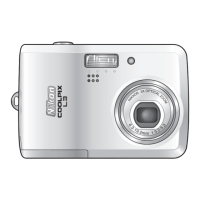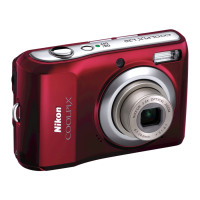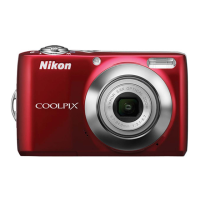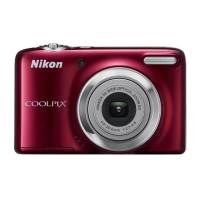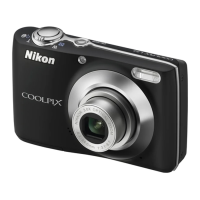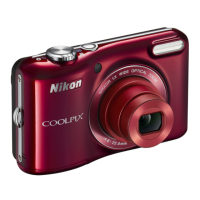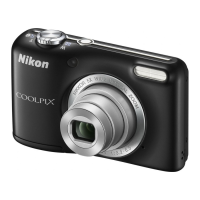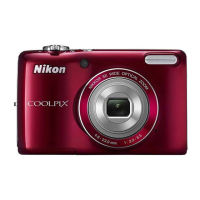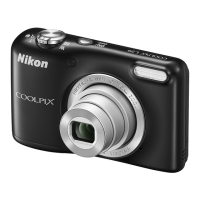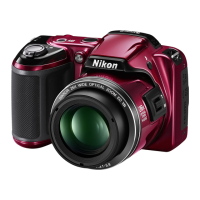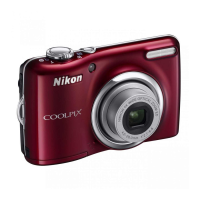
Do you have a question about the Nikon COOLPIX L23 and is the answer not in the manual?
| Megapixel | 10.1 MP |
|---|---|
| Camera type | Compact camera |
| Sensor type | CCD |
| Image stabilizer | Yes |
| Total megapixels | 10.34 MP |
| Image sensor size | 1/2.9 \ |
| Image formats supported | JPG |
| Maximum image resolution | 3648 x 2736 pixels |
| Still image resolution(s) | 640 x 480, 1024 x 768, 2048 x 1536, 2592 x 1944, 3264 x 2448, 3584 x 2016, 3648 x 2736 |
| Digital zoom | 4 x |
| Optical zoom | 5 x |
| Combined zoom | 20 x |
| Focal length range | 4 - 20 mm |
| Maximum aperture number | 6.8 |
| Minimum aperture number | 2.7 |
| Number of aspheric elements | 3 |
| Lens structure (elements/groups) | 6/5 |
| Maximum focal length (35mm film equiv) | 140 mm |
| Minimum focal length (35mm film equiv) | 28 mm |
| Focus adjustment | Auto |
| Normal focusing range | 0.3 - ∞ m |
| Closest focusing distance | 0.03 m |
| Macro focusing range (tele) | 0.6 - ∞ m |
| ISO sensitivity | 80, 1600, Auto |
| ISO sensitivity (max) | 1600 |
| ISO sensitivity (min) | 80 |
| Fastest camera shutter speed | - s |
| Flash modes | Red-eye reduction |
| Power source type | Battery |
| White balance | - |
| HD type | Not supported |
| Video resolutions | 320 x 240, 640 x 480 pixels |
| Motion JPEG frame rate | 30 fps |
| Maximum video resolution | 640 x 480 pixels |
| Analog signal format system | NTSC, PAL |
| Memory slots | 1 |
| Internal memory | 22 MB |
| Compatible memory cards | SD, SDHC, SDXC |
| Display diagonal | 2.7 \ |
| Display resolution (numeric) | 230000 pixels |
| USB version | 2.0 |
| Product color | Black |
| Battery type | AA |
| Battery technology | Alkaline |
| Battery life (CIPA standard) | 220 shots |
| Number of batteries supported | 2 |
| Cables included | USB |
| Depth | 29.3 mm |
|---|---|
| Width | 96.7 mm |
| Height | 59.9 mm |
| Weight | 170 g |
Essential precautions to prevent damage or injury during use.
Regulatory and safety notices for US customers, including FCC compliance.
Regulatory notice for Canada and European collection symbol information.
Purpose of the manual and explanation of its symbols and conventions.
Details on product support, accessories, test shots, and manual disclaimers.
Identification of camera body components and strap attachment.
Detailed layout of camera controls, ports, and the monitor display.
Explanation of icons displayed on the monitor during shooting.
Explanation of icons displayed on the monitor during playback.
Functions of the shooting and playback mode buttons.
How to navigate menus and make selections with the multi selector.
Accessing and using the camera's main menu system.
Switching menu tabs and operating the shutter button.
Primary steps for powering the camera and battery information.
Battery management, power sources, and auto-off features.
Setting camera language, time zone, and date.
Customizing date format and fine-tuning time settings.
Procedures for managing memory cards in the camera.
Card formatting, write protection, and general usage guidelines.
Initial setup and understanding indicators in Easy Auto mode.
Features, indicators, and settings like motion detection in Easy Auto mode.
Composing shots, including face detection framing.
How to use zoom controls and understand digital zoom.
Steps for focusing and taking pictures.
Notes on autofocus, face detection, and flash operation.
How to navigate and view captured images.
Procedures for deleting single or multiple images.
How to choose different flash modes.
Comprehensive details on flash usage, modes, and red-eye reduction.
How to set up and use the self-timer for delayed shots.
Adjusting image brightness for better exposure.
Overview of available shooting modes.
Easy Auto mode scene selection and face detection notes.
Guide to choosing specific scene modes for optimized shooting.
Details and characteristics of Portrait and Landscape scene modes.
Details and characteristics of Sports and Night Portrait scene modes.
Details and characteristics of Party/Indoor and Beach scene modes.
Details for Sunset, Dusk/Dawn, and Night Landscape modes.
Details for Close-up scene mode.
Details for Food and Museum scene modes.
Details for Fireworks, B&W Copy, and Backlighting modes.
Details for Panorama Assist scene mode.
Step-by-step guide for capturing panorama sequences.
Using panorama assist and the Panorama Maker 5 software.
How the camera automatically captures smiles and softens skin tones.
Important notes, functions, and auto-off behavior in Smart Portrait mode.
Adjusting image mode, skin softening, and blink proof.
Overview of settings available in Auto mode.
How to use macro mode for capturing close-up subjects.
Details on adjusting image mode, white balance, continuous, and color options.
Explanation of image quality and size settings.
Information on how many images can be saved.
How to set white balance for accurate color.
Procedure for manually setting white balance.
Explanation of different continuous shooting modes.
How to adjust colors for vividness or monochrome.
List of settings that cannot be used simultaneously.
Navigating and performing actions on single images in playback.
Viewing multiple images via thumbnails or calendar view.
Using the calendar view to find and view images.
Magnifying images during playback for closer inspection.
Using D-Lighting and Skin Softening for image enhancement.
Managing prints, slide shows, and image protection.
Steps to create a print order for selected images.
Configuring print order details and identifying specified images.
Printing date/info, managing print orders, and the Print Date feature.
How to view images in an automatic slide show.
Safeguarding selected images.
How to select multiple images for batch operations.
Changing the orientation of captured images.
Transferring images between internal memory and memory card.
Overview of available in-camera image editing features.
Using D-Lighting to improve image brightness and contrast.
Applying skin softening to portraits for smoother skin tones.
Creating smaller image copies for email or web use.
Cropping images to reframe subjects or adjust composition.
Information on how cropping affects image dimensions.
How to record videos with sound.
Adjusting video quality and other recording parameters.
Details on available movie resolution and frame rate settings.
How to play back and delete recorded movies.
Steps for viewing images on a television.
How to connect the camera to a computer for image transfer.
Procedure for transferring photos from camera to computer.
Instructions for using the Nikon Transfer 2 software for image transfer.
Proper procedure for disconnecting the camera after transfer.
Using card readers, software, panorama creation, and file naming conventions.
General steps for printing images directly from the camera.
Steps to establish a direct connection between camera and printer.
Process for printing individual images with custom settings.
How to print multiple images with specified settings.
Selecting images for printing and setting paper size.
Using Digital Print Order Format and paper size settings.
Introduction to the setup menu and how to access it.
Navigating the setup menu and accessing common settings.
Customizing the screen displayed when the camera turns on.
Setting the camera's clock and time zone.
Adjusting time zones for travel, including daylight saving.
Clock battery info, DST, and imprinting dates on images.
A list of time zones supported by the camera.
Adjusting monitor brightness and information display.
Customizing the information shown on the monitor.
Enabling the imprinting of date and time on images.
Configuring electronic vibration reduction for image stabilization.
Adjusting motion detection for blur reduction.
Configuring autofocus assist and operational sounds.
Managing power saving features like auto-off and sleep mode.
Procedures for formatting storage media.
Setting camera language and video output mode.
Enabling detection of blinking eyes in portraits.
How to use the screen that appears when blinking is detected.
Restoring camera settings to factory defaults.
What happens when resetting and which settings are preserved.
Selecting battery type and checking firmware version.
Essential precautions for maintaining the camera's condition.
Guidelines for battery maintenance and performance.
Instructions for cleaning the lens, monitor, and camera body.
Proper storage, monitor display characteristics, and image smear phenomenon.
List of compatible optional accessories for the camera.
List of compatible SD, SDHC, and SDXC memory cards.
Explanation of how image and movie files are named and organized.
Common error messages and their corresponding solutions.
Error messages related to image saving, editing, movie recording, and memory.
Error messages concerning file playback, protection, lens, communication, and printer issues.
Troubleshooting printer paper loading and ink errors.
Solutions for problems related to the monitor, settings, and power.
Troubleshooting for camera malfunctions and shooting problems.
Solutions for problems with flash, zoom, and image quality.
Troubleshooting playback errors and issues with functions or connectivity.
Troubleshooting issues related to peripherals, software, and printing.
Technical details of the camera's hardware and capabilities.
Technical specifications related to exposure, flash, interface, and languages.
Physical dimensions, operating conditions, power sources, and battery performance.
List and explanation of supported industry standards.
